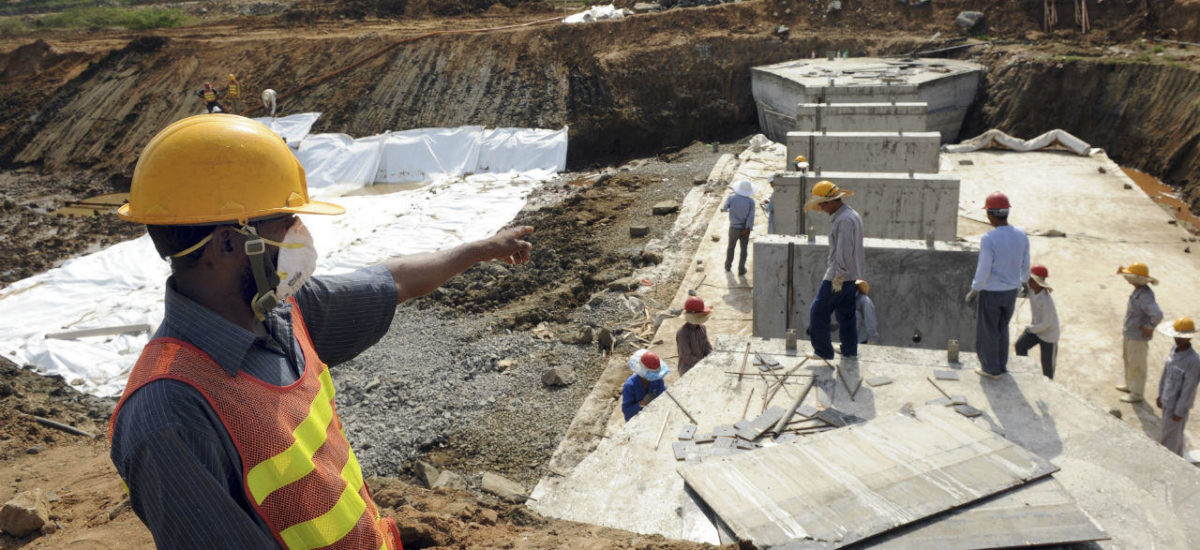Photo courtesy of France 24
The beginning of the southwest monsoon season has triggered heavy rains causing flash floods and mud slides across several districts across the country. The risk of increased extreme weather events – heavy rainfalls and floods, drought and storms – have become inevitable as consequences of continuous climate change. As a result, Sri Lanka must be climate conscious in all its activities, especially when it comes to development planning.
The annual cycle of floods and droughts causes significant economic and social stresses. This cyclical configuration diminishes the capacities of the families to return to at least their status quo in the long run. The main causes for the adverse impacts due to extreme weather events are ignoring climate change and unsustainable development planning. The most vulnerable districts identified by UNICEF in 2018 for recurrent weather disasters, predominantly the annual monsoons, are Ratnapura, Kalutara, Galle, Matara, Kurunegala, Puttalam, Anuradhapura, Mullaitivu and Batticaloa. The recent floods caused by the south-west monsoon resulted in human and environmental impacts in other areas including the Gampaha district. Floods are inevitable when there is heavy rain but they cannot be attributed only to climate change but also to poor development planning.
While the actual causes for the unprecedented floods in Gampaha are not known, government ministers state that the construction work on the central highway is one of the key reasons, according to media reports. Officials of the Department of Highways and Land Reclamation Corporation said the service lines prepared for the construction of the expressway could be the reason for the floods in Gampaha but the problem would not reoccur since the service lines would be removed once the expressway construction was completed. However, there may be heavy rains before completing the project. The floods in Gampaha have highlighted the need to speed up the project together with emergency measures to avoid or minimise adverse impacts from extreme weather to avoid future disasters. More surprisingly, according to news reports, it is only now that officials are preparing long term plans to control flood situations caused by the construction of the central expressway. Canals, drainage and waterways in the Gampaha district are to be cleaned up immediately. The absence of proper development planning, inclusive of climate data, has made people question whether these development initiatives can enhance their quality of life.
Since the purpose of development planning is to promote sustainable development for improving people’s quality of life, it needs to be climate conscious and adequately prepared for climate emergencies. There are several goals of having a climate conscious planning system for any industry, according to the Planning Institute of Australia, including strategies to protect the natural environment threatened by rapid climate change.
The Meteorology Department has predicted that the southwest monsoon season will bring normal to above normal rainfall. With proper planning in place, the road development projects should have accommodated measures to curb the negative effects of extreme weather.
The development planning should also take account of the fact that ecosystems, which would have helped to curb the impacts of extreme weather events, are degrading. For instance, property developers have filled a significant proportion of the Muthurajawela wetland in the Gampaha district illegally, destroying its ecosystems. Marshlands such as Muthurajawela act as flood buffers, receiving and discharging surface runoff to the Negombo lagoon and to the sea. Illegal construction on these wetlands has aggravated the impacts of sudden climate changes in the Bay of Bengal that cause heavy rains and flooding since the natural waterways to flow into sea have been blocked. Such projects that don’t take climate change into account will keep destroying ecosystems and pave the way towards losing them at an alarming rate.
The recent floods are a good example of uncoordinated development by separate ministries. The Ministry of Highways and Road Development has formulated its development plan without coordinating with the Environment Ministry. The question remains how Environmental Impacts Assessments (EIAs) have been conducted and how they have been passed to continue these projects because there are negative environmental impacts. A proper EIA would have identified the extreme weather scenarios that may affect the project and questioned how to manage the impacts of climate events. If the EIA has been done comprehensively, it would have also taken into account how the road development project would manage the floods. Since early 2000, Sri Lanka has faced the challenge of inadequate EIA consultants and infrastructure to monitor and enforce environmental regulations. New projects take the advantage of these loopholes in the EIA process. Thus, the EIA process must be reviewed and the development planning shouldn’t be confined to ministries or authorities of any one sector but should be inclusive and represent all stakeholders.
Development that meets the needs of the present without compromising the ability of the future generation to meet their needs is considered sustainable development, according to the Brundtland Commission. Sri Lanka is not providing the needs of the present generation while development is challenging the balance of the environment. Adapting to climate change and environmentally friendly development planning is yet to be recognised. The future generations will experience face battles – environmental, economic and social – in fulling their needs.
The Global Climate Risk Index analyses the extent that countries and regions that have been affected by impacts of weather related loss events such as floods, storms and heatwaves. In 2020, Sri Lanka was among the top ten countries that were most affected by climate change. If development projects continue to ignore climate change, Sri Lanka will have to accept the impacts of extreme weather events, especially floods, as the new normal. Year by year the number of victims and the economic losses will increase. Deaths will also be attributed to poor emergency preparedness measures. In a situation where extreme weather events are predicted to increase, this is an urgent call to be climate conscious and foster rapid adaptation measures into development agendas. Otherwise, sustainability will remain to be just a notion for our future generations as well.


